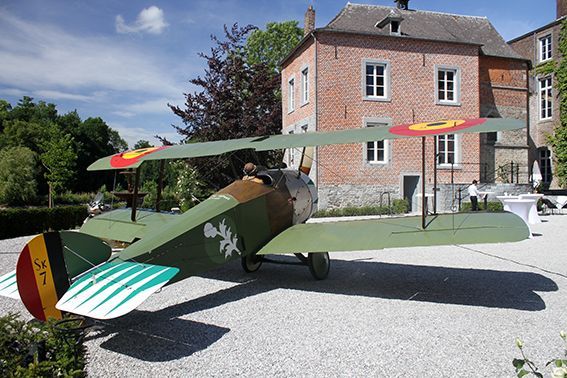
Sopwith Camel
The Sopwith Camel was to the pilots of the First World War what the Spitfire was to their 1940 successors.
This aircraft was derived from the Sopwith "Pup" and came in response to the Albatros D.I fighter aircraft, introduced in the autumn of 1916 by the German Jagdstaffeln, which was equipped with two LMG.08/15 machine guns. It gave the Germans the upper hand in the air battles.
The Camel quickly changed this: well armed, extremely manoeuvrable and very fast.
It became the most famous English fighter aircraft. 5.490 were eventually built. The type was designed at the end of 1916. The first flight took place on December 22, 1916. At the beginning of 1917 the type entered service with the fighter squadrons.
For the first time, two Vickers machine guns were mounted forward of the cockpit and fired through the propeller circle.
The Camel is credited with the highest number of aerial victories of the First World War, destroying 1.294 enemy aircraft in the period from July 1917 to November 1918.
Only the German Fokker DR.I triplane was as manoeuvrable. The armament of two Vickers machine guns firing through the propeller circle of the Camel was a novelty and made it a dangerous weapon.
It was in a Camel that Canadian pilot A.R. Brown shot down German air ace von Richthofen and his Fokker DR.I.
Although extremely manoeuvrable, the Camel was a difficult aircraft to fly: engine, pilot, machine guns and fuel tank (90% of the weight) were in the first three meters, coupled with the gyroscopic effect of the rotary engine. The slightest distraction or mistake could kill the pilot.
Several Allied pilots have come to this conclusion, with or without fatalities. In the hands of an experienced pilot, however, it was a deadly weapon. An English saying from that time stated that the Camel was good for: "a wooden cross, the red cross or the Victoria Cross".
Together with the SPAD S.XIII and the SE5a, this type ensured Allied supremacy in the air.
From the end of 1917, the Belgians also used this aircraft, first in the 1st (later the 9th) and then also in the 11th Squadron. The Belgian Military Aviation had a total of 64 aircraft. The Belgian Camels retained the English Royal Flying Corps livery, with the cockades painted over with the national tricolour.
Well-known Belgian pilots such as Jan Olieslagers and Jean Stampe flew in their respective squadrons with this type of aircraft.
The copy of the Stampe & Vertongen museum is painted in the colours of the 1st squadron of the Belgian Military Aviation and provided with the registration Sk.7 used by Jan Olieslagers in order to pay tribute to this Antwerp born aviation pioneer, promoter of Antwerp airport and friend of Jean Stampe.
Photo captions (top left to bottom right)
- Jan Olieslagers in front of his Sopwith Camel.
- An unfortunate landing. The pilot lived to tell his story.
- For some time, Jean Stampe flew a Spwith Camel.






